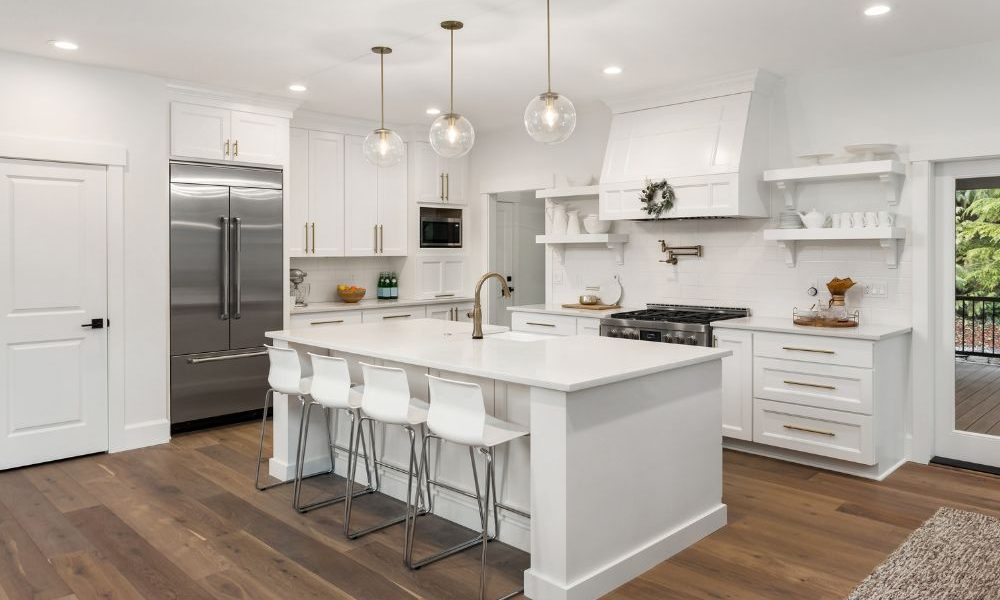Choosing the right flooring for your kitchen is a big decision. It’s one of the most used spaces in your home, and the flooring needs to be both durable and stylish. Whether you’re on a tight budget or ready to splurge, there are plenty of options to suit your needs. This guide will help you navigate through the choices and find the perfect kitchen flooring for your home.
The Importance of Kitchen Flooring
Emily Morrow Finkell, CEO of Emily Morrow Home, emphasizes, “Kitchen flooring sets the tone for the whole room. It’s a large surface area, so it’s important to choose a material that is both durable and stylish” (Source: Emily Morrow Home). The right flooring can enhance the look of your kitchen, make it more comfortable to work in, and even increase your home’s value.
Budget-Friendly Options
Vinyl Flooring
Vinyl is a popular choice for budget-conscious homeowners. It’s affordable, easy to install, and comes in a variety of styles and colors. Modern vinyl flooring can mimic the look of wood, stone, or tile, giving you a high-end look without the high-end price tag.
Personal Anecdote: I recently helped a friend remodel her kitchen, and we chose a beautiful vinyl plank flooring that looked just like hardwood. It was easy to install, and she’s thrilled with how it transformed her space.
Laminate Flooring
Laminate is another cost-effective option. It’s durable, easy to clean, and resistant to scratches and stains. Laminate flooring also comes in a wide range of designs, including options that resemble natural wood and stone.
Erin Gates, an interior designer, says, “Don’t be afraid to have fun with your kitchen flooring. It’s an opportunity to add personality and interest to the space. Consider patterned tiles, bold colors, or unexpected materials” (Source: Elements of Style).
Mid-Range Options
Ceramic and Porcelain Tile
Ceramic and porcelain tiles are durable and water-resistant, making them ideal for kitchens. They’re available in countless styles, from classic to contemporary, and can add a touch of elegance to your kitchen.
Personal Anecdote: In my own kitchen, we chose a porcelain tile with a subtle pattern. It’s been incredibly durable and easy to clean, and it adds a bit of character to the space.
Engineered Wood
Engineered wood offers the beauty of hardwood with added durability. It’s designed to withstand changes in temperature and humidity, making it suitable for kitchens. Plus, it’s often more affordable than solid hardwood.
John McGinnis, a certified kitchen designer, states, “The kitchen is the heart of the home, and the flooring should reflect that. Choose a material that is warm and inviting, and that complements the overall style of your home” (Source: National Kitchen and Bath Association).
High-End Options
Solid Hardwood
For those willing to invest, solid hardwood is a timeless choice. It’s warm, inviting, and can be refinished multiple times to maintain its beauty. While it requires more maintenance than some other options, many homeowners find it worth the effort.
Natural Stone
Natural stone, such as marble, granite, or slate, offers unparalleled beauty and durability. It’s an excellent choice for luxury kitchens, providing a high-end look that’s sure to impress.
Personal Anecdote: I once visited a friend’s home with a stunning marble kitchen floor. It was absolutely gorgeous and added a level of sophistication to the entire house.
Trends and Innovations
Patterned Tiles
Patterned tiles are making a big splash in kitchen design. From intricate mosaics to bold geometric patterns, they can add a unique touch to your kitchen.
Chris Loves Julia, home renovation experts, recommend, “Functionality is key when it comes to kitchen flooring. Choose a material that is easy to clean and maintain, and that can withstand heavy traffic and spills” (Source: Chris Loves Julia).
Sustainable Materials
Eco-friendly flooring options are gaining popularity. Bamboo and cork are both renewable resources that offer durability and a unique look. These materials are not only good for the environment but also add a natural, warm feel to your kitchen.
Heated Floors
For a touch of luxury, consider installing radiant floor heating. Heated floors are especially nice in colder climates, making your kitchen more comfortable year-round.
Integrated Flooring
Young Huh, a professional organizer and interior designer, suggests, “Consider the layout of your kitchen when choosing flooring. If you have an open floor plan, you may want to choose a flooring material that flows seamlessly into the adjacent living areas” (Source: The Neat Method).
Maintenance and Durability
Hardwood and Engineered Wood
Both solid hardwood and engineered wood require regular maintenance to keep them looking their best. Use a damp mop for cleaning and avoid excessive moisture to prevent warping.
Tile
Ceramic and porcelain tiles are relatively low-maintenance. Regular sweeping and mopping are usually sufficient. For grout lines, occasional scrubbing may be necessary to keep them looking clean.
Vinyl and Laminate
Vinyl and laminate floors are among the easiest to maintain. Regular sweeping and occasional mopping will keep them looking good. Be sure to use a cleaner that’s safe for the material to avoid damage.
Stone
Natural stone requires a bit more care. It should be sealed regularly to prevent staining and damage. Clean with a pH-neutral cleaner to avoid etching the surface.
Personalizing Your Space
Color and Pattern Choices
When choosing your kitchen flooring, think about the overall look and feel you want to create. Light colors can make a small kitchen feel larger, while dark colors add warmth and coziness. Patterns can add visual interest and break up large expanses of flooring.
Personal Anecdote: In my kitchen, we chose a light, neutral tile to keep the space feeling open and airy. It was a great decision, especially since our kitchen doesn’t get a lot of natural light.
Mixing Materials
Don’t be afraid to mix different flooring materials to create zones within your kitchen. For example, you could use tile in the cooking area and wood or laminate in the dining area. This approach adds texture and interest to your space.
Conclusion
Choosing the right flooring for your kitchen involves balancing style, durability, and budget. Whether you opt for affordable vinyl, luxurious hardwood, or something in between, there are plenty of options to suit your needs. Remember to consider how you use your kitchen and what materials will best meet your functional and aesthetic goals.
By following these tips and exploring the latest trends, you can find the perfect flooring to give your kitchen a stunning facelift. With the right flooring, your kitchen can become a beautiful, functional space that you’ll enjoy for years to come.




